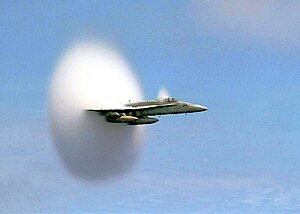Mach number - Simple English Wikipedia, the free encyclopedia

A mach number is a number that describes speed. It is a measure of the speed of an object compared to the speed of sound.[1] Mach number is given as a percentage compared to the local speed of sound. For example, half the speed of sound = Mach 0.5.
Where v is the speed of the object, and a is the speed of sound.[2]
It is named after the Austrian physicist Ernst Mach. When writing a speed as a Mach number, the number comes after "Mach."[2] For example, the Concorde airplane could fly at Mach 2, and a satellite re-enters the Earth's atmosphere at about Mach 25.[3]
Categories of Mach numbers[change | change source]
Flying speed less than Mach 0.8 is called subsonic. Almost all airplanes, helicopters, and other aircraft are subsonic.
Flying speed from Mach 0.8 to Mach 1.2 is called transonic. If an airplane is moving at this speed, then some of the air around it moves faster than the speed of sound, but some of the air moves slower than the speed of sound.
Flying speed from Mach 1.2 to Mach 5 is called supersonic. An aircraft moving at this speed makes a shock wave. This can be heard as a very loud sound called a sonic boom. Supersonic aircraft are used in war, as fighter jets. Today, there are no supersonic aircraft for passenger use. There were some in the past, mainly the Concorde.
Flying speed above Mach 5 is called hypersonic.
References[change | change source]
- ↑ Young, Donald F.; Bruce R. Munson; Theodore H. Okiishi; Wade W. Huebsch (2010). A Brief Introduction to Fluid Mechanics (5 ed.). John Wiley & Sons. p. 95. ISBN 978-0-470-59679-1.
- ↑ 2.0 2.1 Graebel, W.P. (2001). Engineering Fluid Mechanics. Taylor & Francis. p. 16. ISBN 978-1-56032-733-2.
- ↑ Bodie, Warren M., The Lockheed P-38 Lightning, Widewing Publications ISBN 0-9629359-0-5.


 French
French Deutsch
Deutsch
